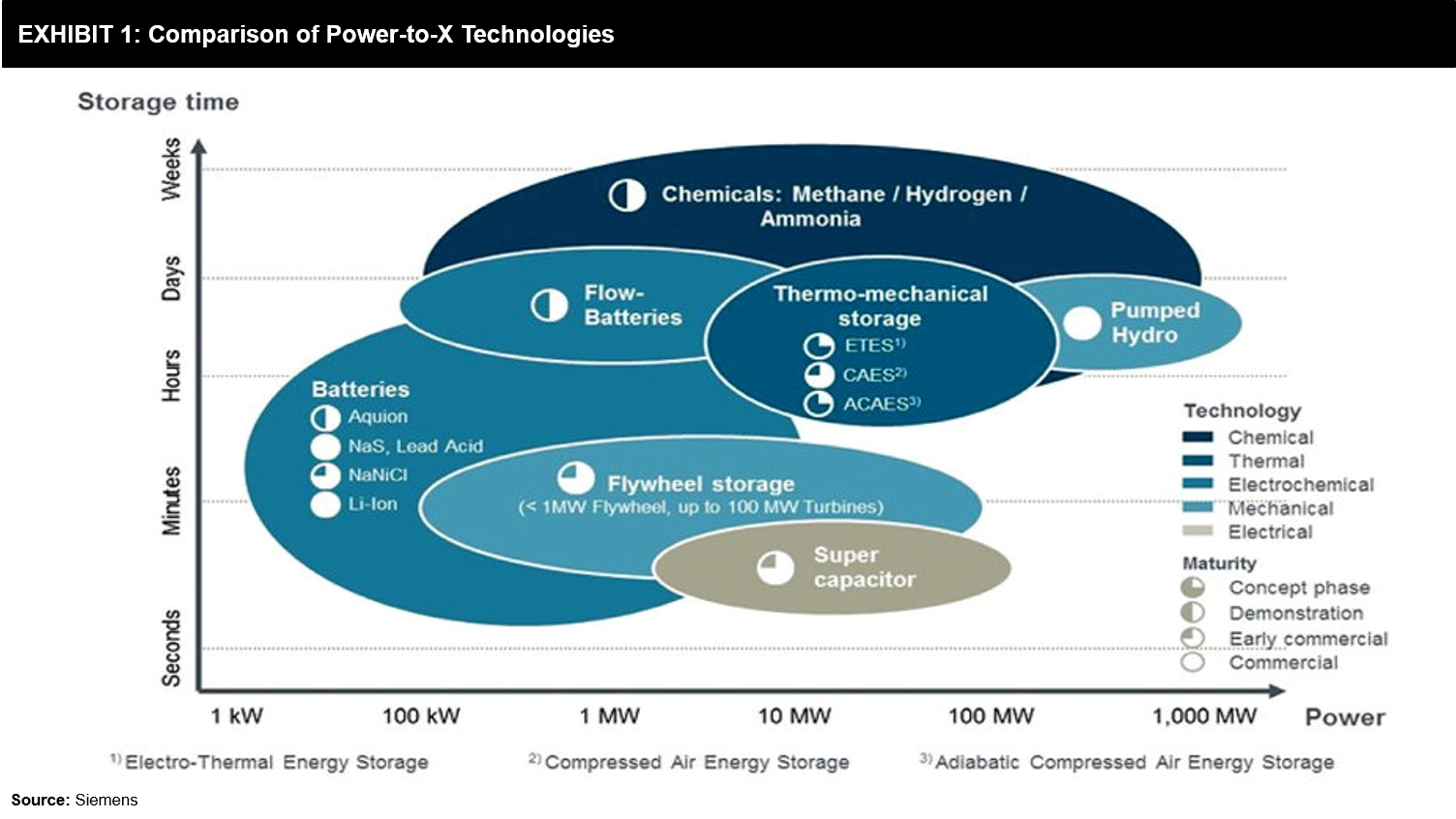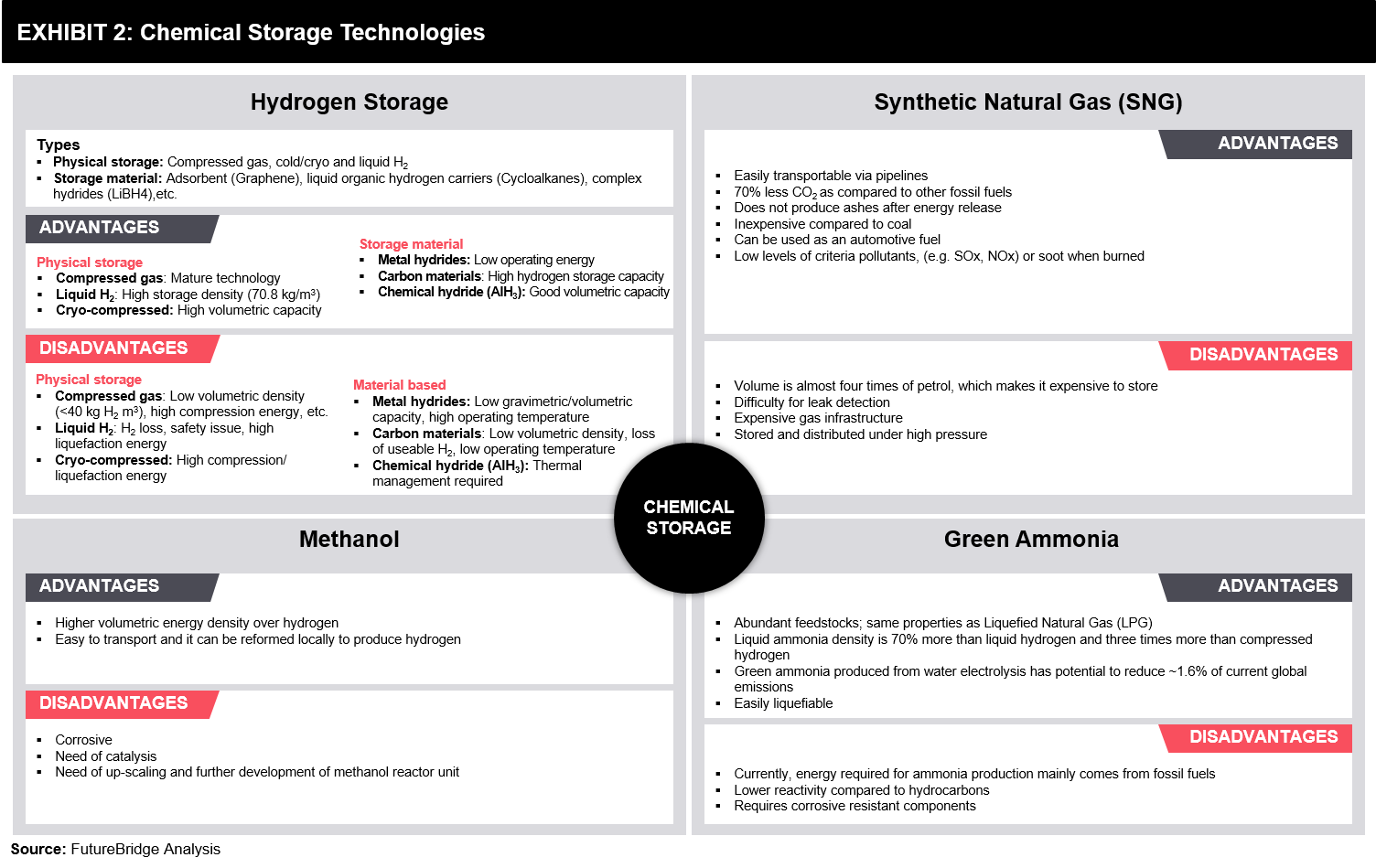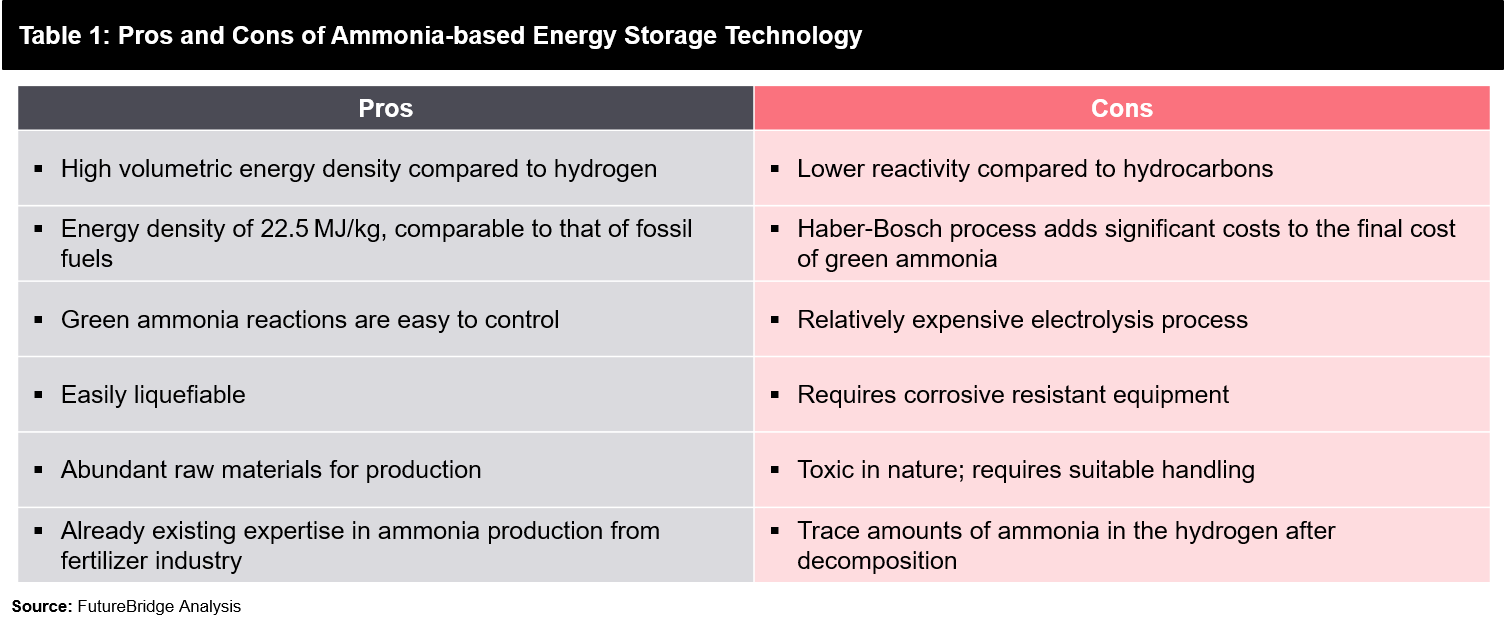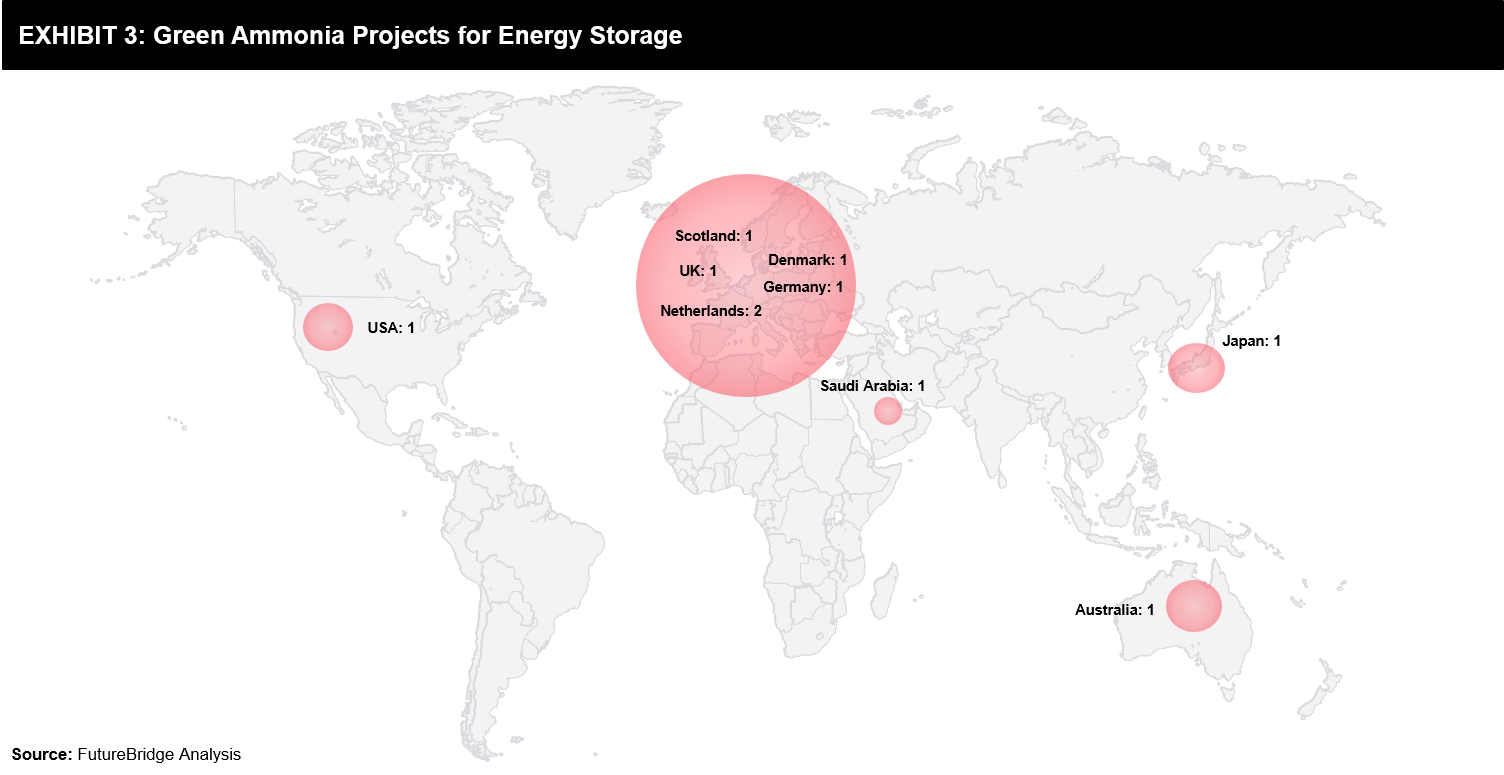Green Ammonia for Energy Storage

Energy Storage Technologies
The renewable energy is playing an important role in transitioning to the decarbonization of the entire energy value chain. But how will the global energy industry accelerate this transition? Renewables and electrification of energy could be a perfect solution. However, intermittency of renewable energy production is the single biggest challenge faced by renewable energy sources, which can be mitigated when it is coupled with an appropriate energy storage system. First, you need to generate electricity from renewable sources and then store it so that it can be extracted whenever there is a demand.
There are several energy storage systems that can be coupled with renewables such as fossil fuel storage, mechanical storage, thermal storage, electrochemical storage, and chemical storage. A combination of the above energy systems works very well for most of the abundant and affordable energy. However, one area where there can be a significant improvement is the carbon emissions associated with fossil fuel-based storage systems. As a result, the energy industry is recently interested in the transition to renewables coupled with non-carbon storage of power as a long term solution to environmental issues.
Exhibit 1 below represents a comparison of different power-to-x technologies against energy retention time and ranges of power.

From the above graph, chemical storage technologies provide clear advantage in terms of storage time and range of power it can store over other similar technologies. It also justifies the recent research activities around various new chemical storage technologies.
However, existing chemical storage technologies include storage in the form of natural gas, kerosene, petrol, diesel, etc. – which has a clear drawback of large emissions. So the possible solution is producing chemical storage options from surplus renewable energy which solves both the hurdles of emissions as well as carbon-free energy storage options at the site of wind or solar farms.
Green Ammonia for Energy Storage
There are four major chemical storage energy storage technologies in the form of ammonia, hydrogen, synthetic natural gas, and methanol. Exhibit 2 below represents the advantages and disadvantages of different chemical storage technologies.

The use of ammonia and hydrogen as fuel or energy storage has been attracting a lot of traction in recent years. Hydrogen has great potential, however, issues associated with hydrogen storage and distribution are currently impeding factors for its implementation. On the contrary, the infrastructure and distribution systems currently in place are far more compatible with ammonia. Additionally, from the point of view of physical properties, ammonia can be easily liquefied at room temperature at about 10 bar or at-33 degrees Celsius under ambient pressure, which is similar in properties to Liquefied Natural Gas (LNG) thus offering easy transportation or storage in the liquid phase.
Overall, ammonia seems a very promising energy storage medium and carrier, but most of the ammonia produced globally is used for fertilizers and comes from the consumption of about 2 percent of the world’s energy which leads to about 1.6 percent of global CO2 emissions. The ammonia produced by utilizing renewables via the Haber-Bosch process, also known as green ammonia could help reduce above mentioned vast emissions in the ammonia industry. Green ammonia has very good energy storage properties to solve the problem of electricity storage for renewable energy plants, like wind farms and photovoltaic solar systems. Ammonia can be produced at these sites to mitigate this issue by utilizing excess renewable energy.
Table 1 lists the pros and cons of ammonia-based energy storage technology:

Most of the efforts in advancing the research on the use of green ammonia for energy storage is concentrated in Europe, with notable projects in countries like Australia, the USA, and Japan.
Exhibit 3 below represents planned and demonstrative green ammonia projects for energy storage globally.

The current Green Ammonia projects for energy storage:
- Siemens Green Ammonia Demonstrator: Siemens is investigating the use of ammonia as a way to store and transport hydrogen in a proof-of-concept plant in Harwell, Oxfordshire, U.K. The demonstrator is producing clean ammonia from green hydrogen and nitrogen via a custom-built Haber-Bosch synthesis unit with a capacity of 30kg of ammonia a day.
- Ammonia Cracker, Germany (Planned): An innovative system to use ammonia as a storage medium for CO2-neutral electricity is currently developed by a joint venture between the University of Duisburg-Essen (UDE) and the Centre for Hydrogen and Fuel Cell Technologies GmbH (ZBT).
- GreenLab Skive, Denmark: Siemens Gamesa partnered with Energifonden Skive to investigate the production of ammonia from wind power for storing surplus energy
- Magnum Nuon and Renewable NH3 production, Netherlands: A demonstration facility planned for 5 years, starting from 2017, by Vattenfall and Nuon is looking into possibilities to replace fossil gas with carbon-free ammonia produced from renewables.
- Renewable Energy to Fuels through Utilization of Energy-Dense Liquids” (REFUEL) program, USA: In the USA, the Advanced Research Project Agency-Energy (ARPA-E), aims to develop scalable technologies for converting renewable energy into energy-rich liquid fuels.
- In Sept 2019, The Australian government agreed to provide A$2.9 million ($2 million) for two studies into using solar and wind power to produce hydrogen for green ammonia.
- In June 2019, JGC Corporation and the Japanese National Institute of Advanced Industrial Science and Technology demonstrated a system to produce hydrogen from solar energy, which is then converted to ammonia, and then used to generate electricity.
- NEOM Project, Saudi Arabia: Air Products, ACWA Power, and NEOM announced a $5 billion, 4-gigawatt green ammonia plant in Saudi Arabia, to be operational by 2025. The aim is to distribute the green ammonia globally and provide carbon-free hydrogen at the point of use.
Outlook
Despite relative low production rates for green ammonia which are far from being considered for commercialization and also the small scale of current pilot and demonstration projects, FutureBridge is of the opinion that green ammonia can be a game-changer for the energy industry due to its physical properties and multiple applications like chemical energy storage for renewables, transport fuel and route for hydrogen production.
The current LCOS in 2018 for green ammonia is around $18 per MWh which is around 6 percent of the total cost of production, storage, and transportation. Reduction in costs of electrolysis and the Haber-Bosch process will play a vital role in achieving feasibility point cost for commercialization and to be comparable with ammonia produced from fossil fuel sources.
Europe will likely emerge as the leader in driving uptake of green ammonia storage technology. Especially, government policies in countries like Germany, where power-to-gas systems are considered crucial for future energy systems with the integration of gas networks, renewables, and electric vehicle charging infrastructure.
References- https://www.cleantech.com/green-ammonia-potential-as-an-energy-carrier-and-beyond/
- https://wwfeu.awsassets.panda.org/downloads/wwf_poland___available_and_future_methods_of_energy_storage.pdf
- https://www.ammoniaenergy.org/articles/green-ammonia-demonstration-plants-now-operational-in-oxford-and-fukushima/
- https://ammoniaindustry.com/siemens-gamesa-plans-green-ammonia-pilot-plant-in-denmark/
- https://www.german-energy-solutions.de/GES/Redaktion/EN/News/2020/20200213-ammonia.html
- https://www.sciencedirect.com/science/article/pii/S0360128517302320
- https://www.frontiersin.org/articles/10.3389/fmech.2020.00021/full#T1
- https://ammoniaindustry.com/power-to-ammonia-the-nuon-eemshaven-case/
- https://www.reuters.com/article/us-australia-hydrogen-incitec-pivot-idUSKBN1WF0CF
- https://www.ammoniaenergy.org/organization/neom/
- https://pv-magazine-usa.com/2019/01/08/ammonia-in-the-mix-for-future-storage-technologies/
- https://www.sciencemag.org/news/2018/07/ammonia-renewable-fuel-made-sun-air-and-water-could-power-globe-without-carbon
futurebridge.com |









